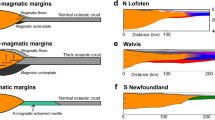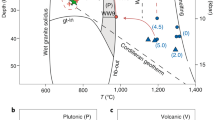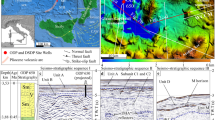Abstract
The processes that give rise to arc magmas at convergent plate margins have long been a subject of scientific research and debate1,2,3,4,5,6. A consensus has developed that the mantle wedge overlying the subducting slab3,4 and fluids and/or melts from the subducting slab itself6,7,8,9,10,11 are involved in the melting process. However, the role of kinematic variables such as slab dip and convergence rate in the formation of arc magmas is still unclear. The depth to the top of the subducting slab beneath volcanic arcs, usually ∼110 ± 20 km, was previously thought to be constant among arcs3,6,12. Recent studies13,14 revealed that the depth of intermediate-depth earthquakes underneath volcanic arcs, presumably marking the slab–wedge interface, varies systematically between ∼60 and 173 km and correlates with slab dip and convergence rate. Water-rich magmas (over 4–6 wt% H2O) are found in subduction zones with very different subduction parameters, including those with a shallow-dipping slab (north Japan), or steeply dipping slab (Marianas). Here we propose a simple model to address how kinematic parameters of plate subduction relate to the location of mantle melting at subduction zones. We demonstrate that the location of arc volcanoes is controlled by a combination of conditions: melting in the wedge is induced at the overlap of regions in the wedge that are hotter than the melting curve (solidus) of vapour-saturated peridotite and regions where hydrous minerals both in the wedge and in the subducting slab break down. These two limits for melt generation, when combined with the kinematic parameters of slab dip and convergence rate, provide independent constraints on the thermal structure of the wedge and accurately predict the location of mantle wedge melting and the position of arc volcanoes.
This is a preview of subscription content, access via your institution
Access options
Subscribe to this journal
Receive 51 print issues and online access
$199.00 per year
only $3.90 per issue
Buy this article
- Purchase on Springer Link
- Instant access to full article PDF
Prices may be subject to local taxes which are calculated during checkout



Similar content being viewed by others
References
Toksoz, M., Minear, J. & Julian, B. Temperature field and geophysical effects of a downgoing slab. J. Geophys. Res. 76, 1113–1138 (1971)
Ringwood, A. The petrological evolution of island arc systems. J. Geol. Soc. 130, 183–204 (1975)
Gill, J. B. Orogenic Andesites and Plate Tectonics 390 (Springer, New York, 1981)
Wyllie, P. Subduction products according to experimental prediction. Geol. Soc. Am. 93, 468–476 (1982)
Davies, J. H. & Stevenson, D. J. Physical model of source region of subduction zone volcanics. J. Geophys. Res. 97, 2037–2070 (1992)
Tatsumi, Y. The subduction factory: how it operates in the evolving Earth. GSA Today 15, 4–10 (2005)
Moran, A. E., Sisson, V. B. & Leeman, W. P. Boron depletion during progressive metamorphism—implications for subduction processes. Earth Planet. Sci. Lett. 111, 331–349 (1992)
Yogodzinski, G. M., Kay, R. W., Volynets, O. N., Koloskov, A. V. & Kay, S. M. Magnesian andesite in the western Aleutian Komandorsky region - implications for slab melting and processes in the mantle wedge. Geol. Soc. Am. 107, 505–519 (1995)
Stern, C. R. & Kilian, R. Role of the subducted slab, mantle wedge and continental crust in the generation of adakites from the Andean Austral volcanic zone. Contrib. Mineral. Petrol. 123, 263–281 (1996)
Kelemen, P. B., Hart, S. R. & Bernstein, S. Silica enrichment in the continental upper mantle via melt/rock reaction. Earth Planet. Sci. Lett. 164, 387–406 (1998)
Plank, T. & Langmuir, C. H. Tracing trace-elements from sediment input to volcanic output at subduction zones. Nature 362, 739–743 (1993)
Jarrard, R. D. Relations among subduction parameters. Rev. Geophys. 24, 217–284 (1986)
England, P., Engdahl, R. & Thatcher, W. Systematic variation in the depths of slabs beneath arc volcanoes. Geophys. J. Int. 156, 377–408 (2004)
Syracuse, E. M. & Abers, G. A. Global compilation of variations in slab depth beneath arc volcanoes and implications. Geochem. Geophys. Geosyst. 7 Q05017 10.1029/2005GC001045 (2006)
Grove, T. L., Chatterjee, N., Parman, S. W. & Medard, E. The influence of H2O on mantle wedge melting. Earth Planet. Sci. Lett. 249, 74–89 (2006)
Till, C. B., Grove, T. L., Withers, A. C. & Hirschmann, M. M. Extending the wet mantle solidus: implications for H2O transport and subduction zone melting processes. AGU Fall Meet. Suppl. Abstract D142A–02 (2007)
Kelemen, P. B., Rilling, J. L., Parmentier, E. M., Mehl, L. & Hacker, B. R. in Inside the Subduction Factory (ed. Eiler, J. M.) 293–311 (American Geophysical Union, 2003)
Pawley, A. Chlorite stability in mantle peridotite: the reaction clinochlore plus enstatite = forsterite+pyrope+H2O. Contrib. Mineral. Petrol. 144, 449–456 (2003)
Iwamori, H. Transportation of H2O and melting in subduction zones. Earth Planet. Sci. Lett. 160, 65–80 (1998)
Schmidt, M. W. & Poli, S. Experimentally based water budgets for dehydrating slabs and consequences for arc magma generation. Earth Planet. Sci. Lett. 163, 361–379 (1998)
Fumagalli, P. & Poli, S. Experimentally determined phase relations in hydrous peridotites to 6.5 GPa and their consequences on the dynamics of subduction zones. J. Petrol. 46, 555–578 (2005)
Medard, E. & Grove, T. L. Early hydrous melting and degassing of the Martian interior. J. Geophys. Res. 111, E1103 (2006)
Kincaid, C. & Sacks, I. S. Thermal and dynamical evolution of the upper mantle in subduction zones. J. Geophys. Res. 102, 12295–12315 (1997)
van Keken, P. E., Kiefer, B. & Peacock, S. M. High-resolution models of subduction zones: implications for mineral dehydration reactions and the transport of water into the deep mantle. Geochem. Geophys. Geosyst. 3 10.1029/2001GC000256 (2002)
England, P. & Wilkins, C. A simple analytical approximation to temperature structure in subduction zones. Geophys. J. Int. 159, 1138–1154 (2004)
Peacock, S. M., Rushmer, T. & Thompson, A. B. Partial melting of subducting oceanic-crust. Earth Planet. Sci. Lett. 121, 227–244 (1994)
Kirby, S. H., Durham, W. B. & Stern, L. A. Mantle phase-changes and deep-earthquake faulting in subducting lithosphere. Science 252, 216–225 (1991)
Molnar, P. & England, P. Temperatures, heat-flux, and frictional stress near major thrust faults. J. Geophys. Res. 95, 4833–4856 (1990)
McKenzie, D. Speculations on the consequences and causes of plate motions. Geophys. J. R. Astron. Soc. 18, 1–32 (1969)
van Keken, P. E. et al. A community benchmark for subduction zone modeling. Phys. Earth Planet. Inter. 171, 187–197 (2008)
Acknowledgements
We thank the reviewers for their constructive comments. This research was supported by the NSF.
Author Contributions T.L.G., C.B.T., N.C. and E.M. participated in the experimental study that led to the phase diagram for water-saturated peridotite melting. T.L.G. and C.B.T. formulated the hypothesis presented in the paper. E.L. carried out the geodynamic modeling. All authors participated in the writing and revision of the paper.
Author information
Authors and Affiliations
Corresponding author
Rights and permissions
About this article
Cite this article
Grove, T., Till, C., Lev, E. et al. Kinematic variables and water transport control the formation and location of arc volcanoes. Nature 459, 694–697 (2009). https://doi.org/10.1038/nature08044
Received:
Accepted:
Issue Date:
DOI: https://doi.org/10.1038/nature08044
This article is cited by
-
Tectonic evolution of convergent plate margins and its geological effects
Science China Earth Sciences (2022)
-
The origin of arc basalts: New advances and remaining questions
Science China Earth Sciences (2020)
-
Aqueous fluids are effective oxidizing agents of the mantle in subduction zones
Contributions to Mineralogy and Petrology (2020)
-
Surface and mantle records reveal an ancient slab tear beneath Gondwana
Scientific Reports (2019)
-
Saline aqueous fluid circulation in mantle wedge inferred from olivine wetting properties
Nature Communications (2019)
Comments
By submitting a comment you agree to abide by our Terms and Community Guidelines. If you find something abusive or that does not comply with our terms or guidelines please flag it as inappropriate.



